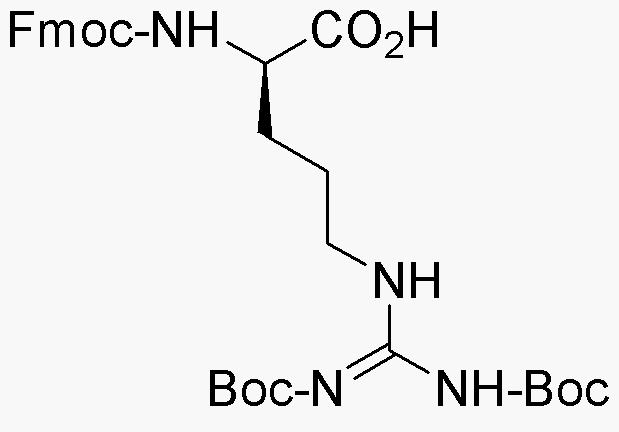Na-Fmoc-Nw,Nw'-bis-Boc-D-arginine is widely utilized in research focused on:
- Peptide Synthesis: This compound serves as a key building block in the synthesis of peptides, particularly in the development of peptide-based drugs. Its protective groups facilitate the selective modification of amino acids, enhancing the efficiency of peptide assembly.
- Drug Development: In pharmaceutical research, it is used to create novel therapeutic peptides that can target specific biological pathways, offering potential treatments for various diseases, including cancer and metabolic disorders.
- Bioconjugation: The compound's functional groups allow for easy conjugation with other biomolecules, making it valuable in the creation of targeted drug delivery systems and diagnostic agents in the field of biomedicine.
- Research on Protein Interactions: It aids in studying protein-protein interactions by providing a means to modify proteins, which can help researchers understand complex biological processes and develop new therapeutic strategies.
- Customizable Research Tools: The versatility of this compound allows researchers to tailor it for specific applications, making it an essential tool in both academic and industrial laboratories for advancing biochemical research.
General Information
Properties
Safety and Regulations
Applications
Na-Fmoc-Nw,Nw'-bis-Boc-D-arginine is widely utilized in research focused on:
- Peptide Synthesis: This compound serves as a key building block in the synthesis of peptides, particularly in the development of peptide-based drugs. Its protective groups facilitate the selective modification of amino acids, enhancing the efficiency of peptide assembly.
- Drug Development: In pharmaceutical research, it is used to create novel therapeutic peptides that can target specific biological pathways, offering potential treatments for various diseases, including cancer and metabolic disorders.
- Bioconjugation: The compound's functional groups allow for easy conjugation with other biomolecules, making it valuable in the creation of targeted drug delivery systems and diagnostic agents in the field of biomedicine.
- Research on Protein Interactions: It aids in studying protein-protein interactions by providing a means to modify proteins, which can help researchers understand complex biological processes and develop new therapeutic strategies.
- Customizable Research Tools: The versatility of this compound allows researchers to tailor it for specific applications, making it an essential tool in both academic and industrial laboratories for advancing biochemical research.
Documents
Safety Data Sheets (SDS)
The SDS provides comprehensive safety information on handling, storage, and disposal of the product.
Product Specification (PS)
The PS provides a comprehensive breakdown of the product’s properties, including chemical composition, physical state, purity, and storage requirements. It also details acceptable quality ranges and the product's intended applications.
Certificates of Analysis (COA)
Search for Certificates of Analysis (COA) by entering the products Lot Number. Lot and Batch Numbers can be found on a product’s label following the words ‘Lot’ or ‘Batch’.
*Catalog Number
*Lot Number
Certificates Of Origin (COO)
This COO confirms the country where the product was manufactured, and also details the materials and components used in it and whether it is derived from natural, synthetic, or other specific sources. This certificate may be required for customs, trade, and regulatory compliance.
*Catalog Number
*Lot Number
Safety Data Sheets (SDS)
The SDS provides comprehensive safety information on handling, storage, and disposal of the product.
DownloadProduct Specification (PS)
The PS provides a comprehensive breakdown of the product’s properties, including chemical composition, physical state, purity, and storage requirements. It also details acceptable quality ranges and the product's intended applications.
DownloadCertificates of Analysis (COA)
Search for Certificates of Analysis (COA) by entering the products Lot Number. Lot and Batch Numbers can be found on a product’s label following the words ‘Lot’ or ‘Batch’.
*Catalog Number
*Lot Number
Certificates Of Origin (COO)
This COO confirms the country where the product was manufactured, and also details the materials and components used in it and whether it is derived from natural, synthetic, or other specific sources. This certificate may be required for customs, trade, and regulatory compliance.


